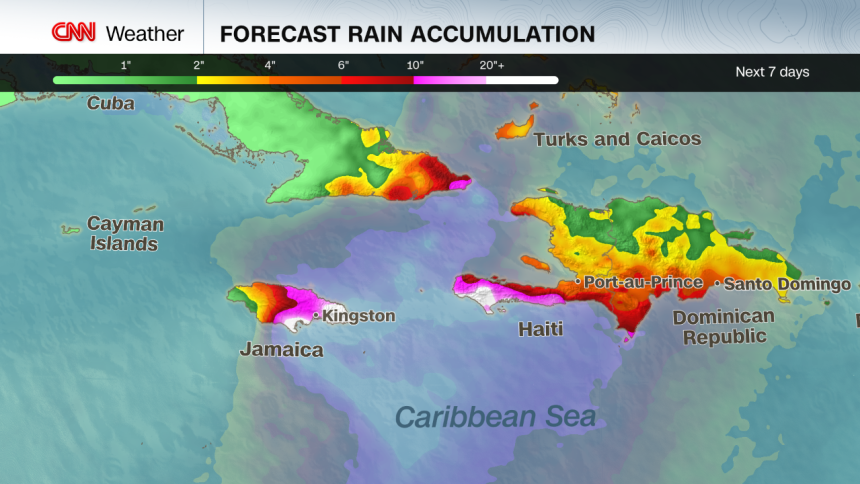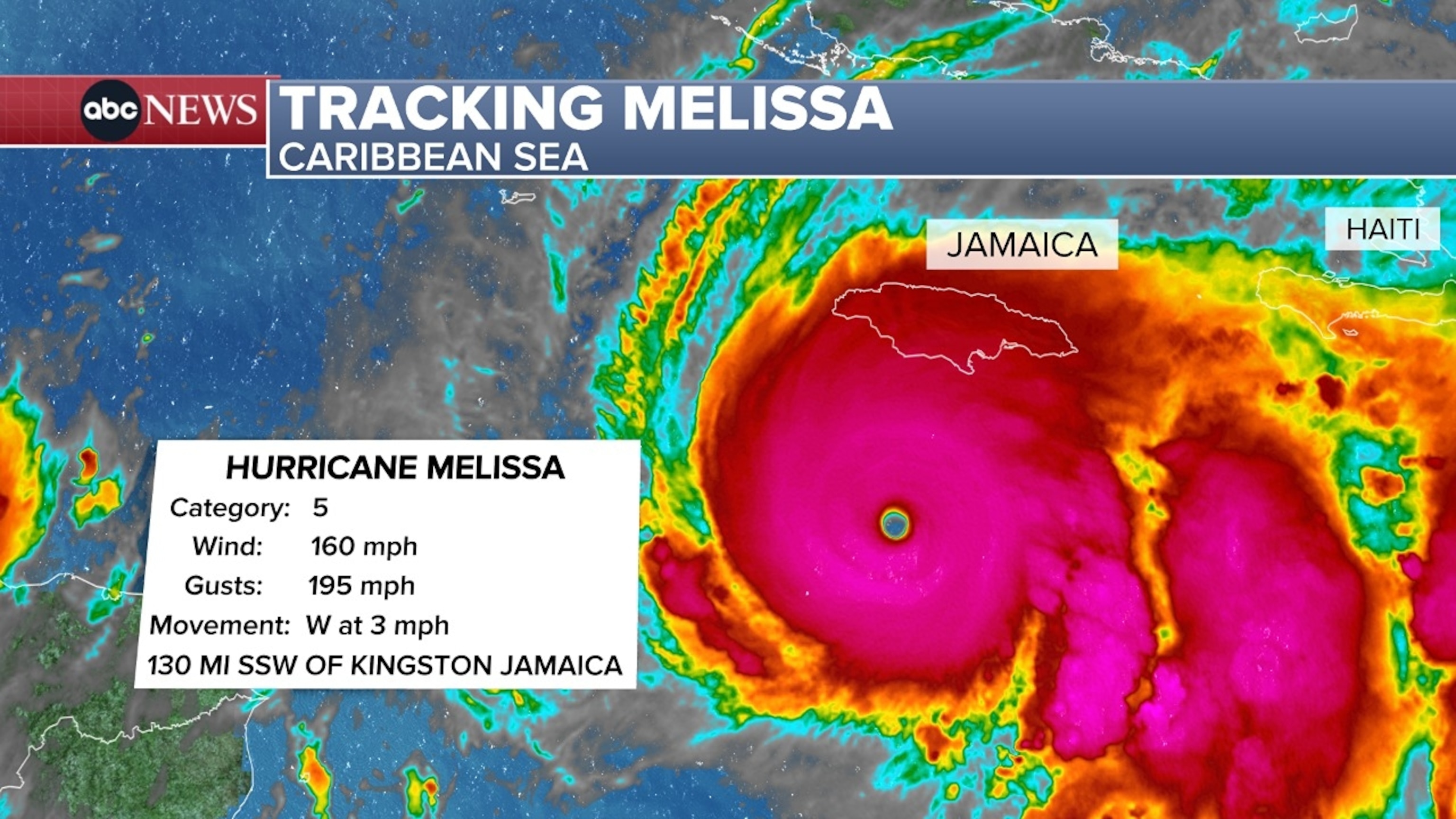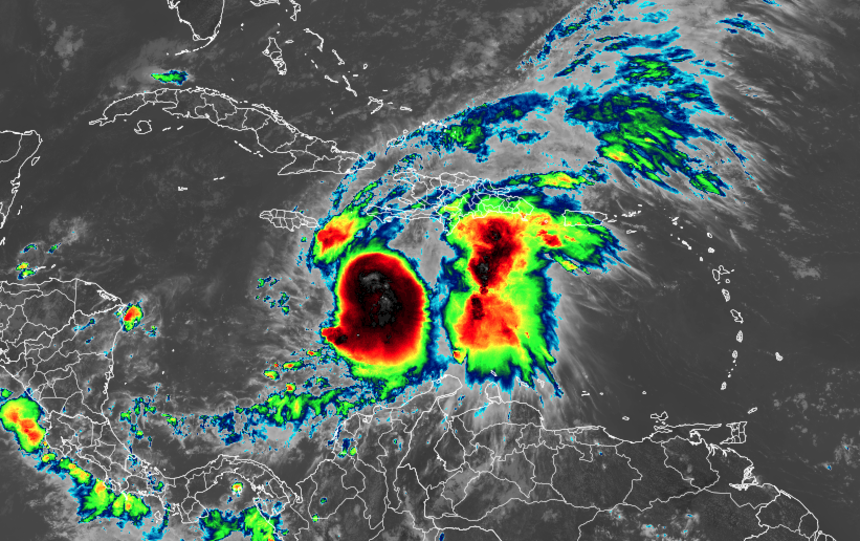Tropical Storm Melissa is forecast to rapidly intensify into a major hurricane this weekend as it lashes Jamaica and parts of the northern Caribbean, bringing days of life-threatening, potentially catastrophic impact.
Jamaica looks to be the epicenter for the worst of Melissa’s triple threat of extreme rainfall flooding, wind damage and storm surge. Melissa could make landfall on Jamaica late Monday or early Tuesday. Haiti also continues to be in thick of Melissa’s destructive flood and landslide threats.
A hurricane warning is effect for Jamaica, where strong winds are expected to begin tonight. Southern Haiti is under a hurricane watch.
Melissa has been moving at a snail’s pace for days and it won’t pick up speed anytime soon as it tracks generally westward through Sunday night. The storm is centered 165 miles southeast of Kingston, Jamaica, and is packing winds up to 70 mph as of Saturday morning.
That slow movement has already caused problems. Torrential rain bands have swamped Haiti and the Dominican Republic for much of the week, causing flooding and triggering landslides. At least three deaths have been reported in Haiti due to the storm, two of which were the result of a landslide, the Haitian Civil Protection Agency said in a statement. In the Dominican Republic, at least one person has died and more than 1,000 people have evacuated or been displaced, officials said Friday.
This explosive strengthening is happening more often as the world warms due to fossil fuel pollution. Three of the four Atlantic hurricanes this season underwent extreme rapid intensification: Erin, Gabrielle and Humberto.
Melissa’s extreme threats
Jamaica, Haiti and the southern Dominican Republic will face the worst of the storm into at least early next week. Next in line for strong winds, storm surge and flooding rain will be eastern Cuba, the southern Bahamas and Turks and Caicos.

“Extensive damage to roads and buildings is expected, potentially isolating communities for an extended period of time,” in Haiti on Saturday, the hurricane center warned. “This is a life-threatening situation and immediate preparations to protect life and property should be taken.”
Jamaica will not only endure Melissa’s torrential rain, but will also have to contend with days of ferocious winds. The nation of nearly 3 million people will likely see hurricane-force winds by Sunday or Monday. The most extreme winds will likely occur as Melissa tracks near Jamaica on Monday into Tuesday. Downed trees, power outages and structural damage could be widespread.
Officials in the country are already preparing for the worst. All public hospitals have been in “emergency mode” since Thursday evening, halting outpatient and elective procedures to ensure more beds are open, according to Christopher Tufton, Jamaica’s Minister of Health and Wellness.
Jamaica’s airports remain open for now, but will likely close within 24 hours of a hurricane warning being issued, according to Daryl Vaz, Minister of Science, Energy, Telecommunications and Transport.
Jamaican Prime Minister Andrew Holness urged people to take the threat seriously at a Friday news conference: “You have been given enough notice that (Melissa) is coming and that it could be disastrous, so take all measures to protect yourself.”
The United States mainland is not expected to be directly threatened by Melissa. Even so, rough surf and rip currents could spread along the US East Coast next week.
Why Melissa’s forecast is so alarming
- It’s barely moving. When a storm crawls, rainfall piles up over the same towns for days. A similar setup produced catastrophic floods in 2017 with Hurricane Harvey, which dumped over four feet of rain on parts of Texas, and in 2019 with Hurricane Dorian, which dropped nearly two feet of rain in the Bahamas and over a foot in parts of South Carolina.
- Mountains magnify the flood threat. Haiti, Jamaica and the Dominican Republic’s steep terrain will force air upward, wringing out more moisture from the storm, just like squeezing a wet sponge, turning tropical humidity into torrents racing downhill. Mudslides are all but guaranteed in this scenario. This happened when Hurricane Helene devastated western North Carolina last year.
- Heat in the Caribbean Sea runs deep. The Caribbean’s exceptionally-warm water extends far below the surface, preventing the usual “stirring up” of cooler water that can weaken hurricanes. Melissa is expected to feast on that deep reservoir of heat, raising the ceiling on its potential intensity.
Hurricane Beryl in July 2024 was the last storm to heavily impact Jamaica. It did not make landfall, but still lashed the island with flooding rain and strong winds as it passed to the south as a Category 4.
CNN Meteorologists Briana Waxman and Mary Gilbert contributed to this report.






You need to be a member of Earth Changes and the Pole Shift to add comments!
Join Earth Changes and the Pole Shift